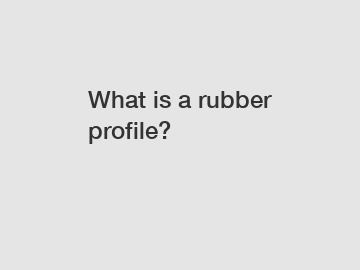What is a rubber profile?
What is a rubber profile?
A rubber profile refers to a specific shape or form made of rubber materials. It is commonly used in various industries for different purposes, such as sealing, protecting, or enhancing the functionality of different products or structures. Rubber profiles can be customized to fit specific applications and are widely utilized in sectors such as automotive, construction, and manufacturing.
The term "rubber profile" stems from the characteristics and versatility of rubber as a material. Rubber exhibits high elasticity, resilience, and durability, making it ideal for creating profiles that can withstand various environmental conditions and mechanical stresses. Its ability to deform under pressure and return to its original shape is crucial for the effectiveness of rubber profiles in different applications.

The process of creating rubber profiles involves several steps. Firstly, the rubber material is formulated, typically using a combination of natural rubber or synthetic rubber compounds. Various additives, such as fillers, plasticizers, and curing agents, are incorporated to enhance the material's properties and processability. The rubber compound is then shaped through different forming techniques, including extrusion or molding, to produce the desired profile shape.
Rubber profiles serve numerous purposes across various industries. In the automotive sector, they are used for sealing applications, such as door and window seals or gaskets, to prevent water, dust, and noise intrusion. These profiles also provide insulation, vibration damping, and protection against impact and harsh weather conditions. In construction, rubber profiles are employed for sealing joints, preventing leaks and ensuring structural integrity. They are also used as edge protectors, bumper strips, and sealing strips in windows and doors.
The significance of rubber profiles lies in their ability to provide functional solutions in diverse industries. By effectively sealing gaps or joints, they contribute to energy efficiency, noise reduction, and improved overall performance of the products or structures. The customization options allow for precise fitting and optimization of the profiles for different applications, enhancing their effectiveness and longevity.
Moreover, the use of rubber profiles has a positive impact on sustainability. Rubber is a recyclable material, and many manufacturers offer eco-friendly options with recycled rubber content. By choosing rubber profiles, industries can contribute to waste reduction and environmental conservation.
In conclusion, a rubber profile is a specific shape or form made of rubber materials, with its characteristics and versatility derived from the unique properties of rubber. The process of creating rubber profiles involves formulation, shaping, and customization. These profiles are widely used in various industries for sealing, protecting, and enhancing the functionality of different products or structures. The significance of rubber profiles lies in their ability to provide functional solutions, customization options, and positive impact on sustainability.
For more EPDM Sponge Strip, PVC Trim Strip, EPDM Sponge Stripinformation, please contact us. We will provide professional answers.
247
0
0

Comments
All Comments (0)